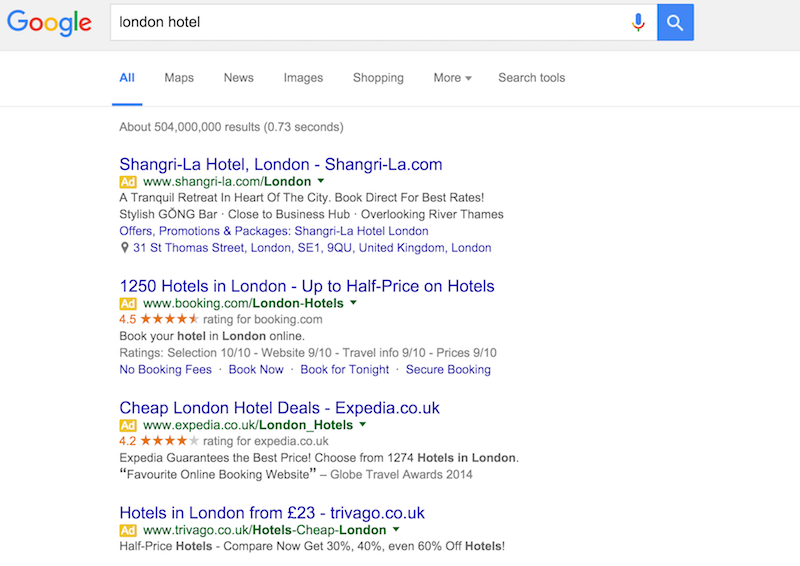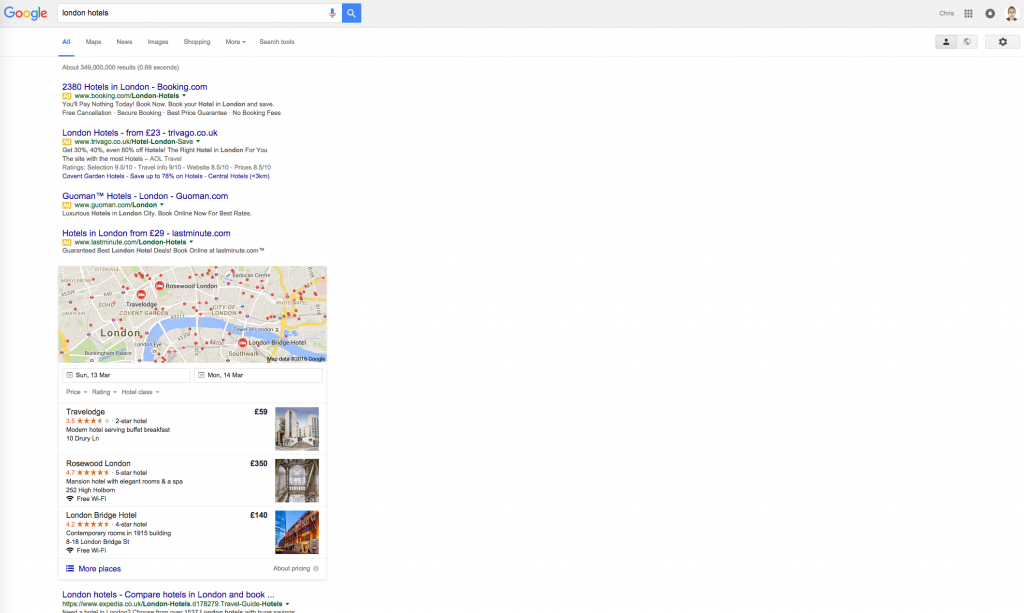You’ll have no doubt read about Google’s recent jettisoning of its sidebar ads, in favour of more ads placed at the top of the page. This is going to have a number of effects that search marketers will need to contend with.
It’s also going to affect users, as people may adjust to the ad-heavy new look. I thought it might be interesting to think about how Google might measure the changes.
Here are 14 KPIs and metrics that will reveal how the new layout – and the demoted organic results – impacts on revenue and user behaviour.
No doubt there are some others that I’ve missed, so do leave a comment below if you have anything to add.
1. Total revenue
This is the big one, the primary KPI, and I dare say the reason for the change.
Google continually tests all manner of tweaks and changes to its algorithm, its page layouts and its user interface. As a commercially-focused entity it will only willingly release changes that generate more revenue for its shareholders to marvel at.
Presumably this KPI has increased. Fewer ads on the page, but more prominent ads, and more competition among advertisers. That probably means more clicks, and higher keyword prices.
In 2015 Google generated a whopping $67bn in ad revenue. It is facing some big challenges with regards to protecting and growing mobile ad revenues. Let’s see how 2016 shapes up…
2. Average revenue per user
Is Google generating more money across the board?
I’d have thought that ARPU would also have increased, at least initially, but longer term I wonder about how much additional revenue Google can squeeze out of its search users, especially those who know the difference between an ad and an organic result.
3. Conversion rate
This can be a dangerous metric to focus on, for a number of reasons. It’s pretty simple to boost your conversion rate, but it needs to be done in a meaningful way.
We might assume that four big ads at the top of the page result in a higher click rate on ads. I think that’s probably the case. Mission accomplished, for Google.
But then again four ads might not be as good as 10-13, as far as the volume of clicks is concerned. Conversion rate will have dropped, if total ad clicks have reduced.
Google won’t be too bothered about this so long as the additional competition and keyword inflation results in revenue growth.
4. Total ad clicks
Following on from above, exactly how many ads are being clicked on?
This is where Google makes its money, and it will want this number to increase, but the supercombo of in your face ads and higher PPC fees might offset a decline in clicks.
I’m keen to see whether there is an overall decline in click quality for poorly-targeted ads, not that it will affect Google in the short term. Advertisers will need to keep their wits about them.
5. Total clicks on organic results
Are users chasing the organic listings down the page, or are they blindly clicking the ads instead? This is the one billion dollar question (at least!).
A couple of weeks ago Moz reported that more than a third of the SERPs had four ads. Many of these pages require the user to scroll in order to see any organic results.
For non-commercial queries that return four top ads, the user experience is going to start to suck. The irony is that if this were another website Google might give it a page quality penalty (too many ads, not enough visible content).
Anyway, something’s got to give. Either the user needs to get into the habit of delving deeper into Google in order to find what they are looking for, or, simply click on one of the links in the paid ads.
6. Clicks per search query
In theory, one quick post-query click is the ideal. That indicates that the algorithm is doing its job by presenting the most relevant result at the top of the page.
The trouble is that Google is allowing advertisers to control what appears top for many queries. More paid results means less algorithmically-determined relevancy. Relevancy appears to have taken a back seat.
I’m inclined to suggest that users trust the algorithm more than they trust advertisers (not that they always know the difference between the two things).
If users dive in and out of the top ads (as they often do with organic results, yo-yoing in and out of websites) then average clicks per query are going to rise, and advertisers may become dissatisfied.
Advertisers certainly need to be on top of their targeting game to avoid curiosity clicks, where users casually click on the results.
7. Average time to click
How long are people hanging around for?
For a lot of websites it pays to have a sticky site, but for a search engine the opposite is true. A sign of quality on a search engine is a short average browse time, assuming the user clicks on a result. Ideally, the first result you’re shown would be the one you want to see, and the one you click on. Good search engines are somewhat automagic in this respect.
But if people are spending longer on Google it could be a sign of confusion (“why is Google showing me all these ads?”), or maybe the paid results at the top of the page are not perceived as being relevant.
Forcing the user to scroll down the page to see the organic results will also cause a short delay.
Any which way you look at it, if average time to click rises it would indicate that the user experience has worsened. Google is not immune to people feeling that things have changed for the worse. Here be dragons.
8. Pages per session
How many people are clicking to the next page to see relevant results?
This is linked to browse time, and as Google skews search results towards commercial pages, we may see more people wading into page two to find what they’re looking for.
Indeed, it is said that the second page of Baidu has become a new battleground for SEOs, after it loaded up its first page with ads.
It makes sense. Users may become conditioned to clicking beyond page one to see organic results. That could prove to be an opportunity for search marketers. Imagine having to de-optimise your pages to achieve positions #11-15!
It’s also worth saying that additional clicks to discover the content is a pain in the ass for users.
9. Bounce rate
Still haven’t found what you’re looking for?
I suspect most people stick around to unearth the right kind of links. It’s the nature of search, after all: find and seek. But if the top results are all ads then the immediacy vanishes, and perhaps, over time, people will start to tune out, or look elsewhere for pointers.
Immediacy is a big deal. The instantaneous ‘here’s what you’re looking for’ factor should not be underplayed: it’s a big reason why people use Google. It’s also mirrored in the interface, as Google proudly displays the time it took to return the results.
Maybe the interface needs a flashing arrow pointing down the page, or a jump link…
10. Average searches per session
Users may start to finesse their queries to try to see the organic results, or just to make the ads vanish.
It’s a bit like ‘time to click’ – this is a not something a search engine wants see go up.
For most sites, an increase in usage is a good thing, but for a search engine the goal is to help people find what they need with the minimum amount of friction.
11. Average monthly searches per user
If this starts to fall it could be a sign that users are bailing out. Warning bells should sound at Google HQ.
12. Visitor loyalty
Say hello, wave goodbye?
If monthly searches per user starts to dip then is it linked to loyalty? Trouble, if so.
Will users react unfavourably to a visible page of ads? I guess it depends on what they’re looking for. But certainly this is something that could hurt Google in the long run.
Also, where do we go next? What’s the natural extension of a full screen of ads? A full page of ads? Two pages? Pop-ups? Autoplay video ads?
Users will run for their lives…
It seems crass to suggest that Google, which is synonymous with search, would fade into irrelevance as a search engine. Consumers can be fickle, and they may feel that Google is becoming a smarter version of the Yellow Pages.
Weirder things have happened in business, and certainly in tech.
13. Clicks by device
What’s the breakdown of clicks for desktop users, mobile users, etc?
The single column lends itself to mobile, and perhaps Google wants to unify the search experience. Will desktop clicks fall or rise?
I have a big monitor, and there’s a hell of a lot of white space on my desktop. Might we expect to see an upwardly-responsive multi-column layout soon?
14. Satisfaction
A firm as big as Google must surely measure user satisfaction. It’s rather different to measuring customer satisfaction, which is somewhat easier, but there are implicit and explicit metrics (including some of the above) that will help it figure out sentiment. No doubt it runs focus groups and audience surveys too
Further Related Articles:








































